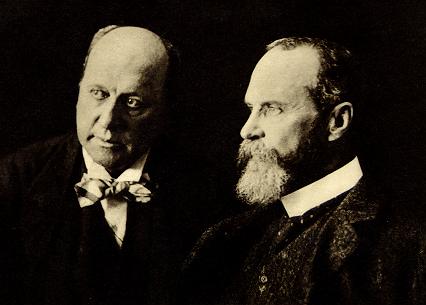"Fannie, Freddie Face Pressure to Revamp as U.S. Aid Increases
By Dawn Kopecki
April 15 (Bloomberg) -- Fannie Mae and Freddie Mac are under pressure from lawmakers to revamp their operations as the mortgage-finance companies tap more government money to survive.
Among the options under discussion are combining the companies, breaking them up or reshaping their missions.
“It’s highly unlikely that they would return to the way they used to be,” said Ira Jersey, the head of U.S. interest rate strategy at RBC Capital Markets in New York.
Regulators seized Fannie and Freddie in September amid a rise in mortgage delinquencies that led to a combined net loss of $108.8 billion last year at the companies, the largest sources of financing for new U.S. home loans. The Treasury Department has injected $59.8 billion in emergency funds into the companies, including $46 billion issued two weeks ago.
Executives at Washington-based Fannie have discussed internally the possibility of taking over McLean, Virginia-based Freddie’s operations, according to people familiar with the matter. A formal approach isn’t imminent, said the people, who asked not to be named because the discussions are private.
The Treasury has agreed to give the two government- sponsored enterprises, or GSEs, as much as $400 billion through Dec. 31. That agreement probably will need to be extended by Congress before year-end, said Karen Shaw Petrou, a managing partner of Federal Financial Analytics Inc., a Washington-based research firm.
‘New Structure’
“There will be a massive re-write of the GSEs into some new structure,” though probably not this year, Petrou said.
House Financial Services Committee Chairman Barney Frank, a Massachusetts Democrat, is exploring ways to separate the companies’ private and public missions, said Steve Adamske, a Frank spokesman.
A merger would be the quickest way for regulators to cut costs by reducing Fannie and Freddie’s combined 11,000-person workforce, shedding underperforming mortgage assets and reducing the bureaucracy of running two companies with identical functions, said Christopher Whalen, co-founder of Institutional Risk Analytics in Torrance, California.
Substantial movement toward a merger may not come quickly. James Lockhart, who oversees the companies as director of the Federal Housing Finance Agency, has said they will remain under government control until the housing market recovers, and the Obama administration has ordered Fannie and Freddie to focus on helping homeowners meet their mortgage payments.
Public Mission
“It’s got to happen; we’re not going to put them back the way they were,” Whalen said of a merger. “The only way we’re going to be able to manage them is if we squeeze every last ounce of savings out of the administrative side and just focus on trying to keep the loss number under control.”
Brian Faith, a Fannie spokesman, and Michael Cosgrove, a spokesman for Freddie, declined to comment on the possibility of a merger or other restructuring.
Fannie, created by the government in 1938, and Freddie, formed in 1970 to be a competitor, ensure that banks have cash available to make loans by buying mortgages or guaranteeing securities they help create from the debt. Together they own or guarantee about 56 percent of all U.S. home loans.
Freddie has received $44.6 billion in federal aid, about three times as much as Fannie. Freddie’s tab at the Treasury will cost it at least $4.6 billion in annual interest payments, almost triple what Fannie owes.
“With both of them as wards of the state, do you need two of them?” said Joshua Rosner, an analyst with Graham Fisher & Co. in New York.
Ousted Management
Lockhart’s agency put Fannie and Freddie under its control and forced out executives after examiners said the two may be at risk of failing, threatening further damage to the housing market.
Top management of the companies remains in flux. Freddie Chief Executive Officer David Moffett unexpectedly quit last month. Fannie CEO Herb Allison emerged this week as the leading candidate to run the $700 billion U.S. bank-rescue program, according to a person familiar with the matter.
Under Frank’s plan, a government trust fund would assume the companies’ responsibilities to subsidize rental housing and a remaining company would continue to do business in the private mortgage market, according to Adamske, the lawmaker’s spokesman. He said it’s too soon to say what the final structure would look like.
To make Frank’s proposal work, regulators may need to put one company into receivership, a process similar to bankruptcy, said Armando Falcon, who was Fannie and Freddie’s government supervisor from 1999 through mid-2005. The fastest way would be for “one to buy all the assets and assume all the liabilities of the other, place the rest of it into receivership and wind it down,” he said.
Home Loan Banks
The solution is to “break them up,” said Representative Spencer Bachus of Alabama, the top Republican on the House Financial Services Committee. “One possibility that I’ve looked at is letting the Federal Home Loan Banks take over some of their obligations and operations.”
The Federal Home Loan Banks are 12 government-chartered cooperatives that lend money for mortgages at below-market rates to their membership of more than 8,100 thrifts, commercial banks, insurance companies and credit unions.
Daniel Mudd, ousted as Fannie’s CEO after the government’s Sept. 6 takeover, said too much is being demanded of the companies, and that lawmakers should rethink the idea of shareholder-owned firms with public missions.
‘Robust’ Debate
“We need to have a robust policy debate,” Mudd, 50, said in an interview. “Do you want large companies to be focused exclusively on housing finance, albeit prone to produce the result -- just like we’ve seen recently -- that when the housing market goes down, there will be blood?”
Falcon, now an industry consultant at Canonbury Advisors in Alexandria, Virginia, said a public-private hybrid doesn’t work. He has advised other nations to avoid following the Fannie and Freddie example in developing their secondary mortgage markets, he said.
“There are just too many inherent risks in following the U.S. model,” he said. “All that has been proven out.”
To contact the reporter on this story: Dawn Kopecki in Washington at dkopecki@bloomberg.net."







































No comments:
Post a Comment